Tasmania - state of Australia
Tasmania is the island state of Australia, southeast of the mainland. Tasmania encompasses the main island of Tasmania, the 26th largest island in the world, and over 1000 smaller islands - both inhabited and uninhabited. It is the smallest state in Australia by both area and by population, with just over 500,000 permanent residents. Over 45% of Tasmania is protected by national parks and world heritage sites, and it features diverse climates, flora and fauna, many of which are found nowhere else in Australia, and a rich heritage, both Indigenous and post-colonial.
You'll find the inhabitants notably more polite, friendly and helpful than in big cities on the mainland such as Melbourne, Sydney and Brisbane.
Regions

The most populous region of Tasmania, which includes Tasmania's capital and Australia's second oldest city, Hobart, which sits at the foot of kunanyi / Mount Wellington.
This area encompasses the only other major city in Tasmania, Launceston and the Tamar Valley, the mountainous region of Ben Lomond, the Midlands, and the North East along with the stunning beaches including the Bay Of Fires and Wine Glass Bay, voted some of the most beautiful beaches in the world.
Other
- Macquarie Island is a Subantarctic island around 1500 km south-southeast of Tasmania. While it's administered as part of the Huon Valley, it's geologically, physically, and ecologically closer to many other Subantarctic islands, particularly the New Zealand Subantarctic Islands.
Cities and townships
- Hobart 📍 – the state capital and largest city located in the south of the island
- Bicheno 📍 – beach town on the east coast
- Burnie 📍 – the fourth largest city in Tasmania
- Devonport 📍 – home to the Spirit of Tasmania ferry, third largest city
- Huonville 📍 – gateway to southern Tasmania
- Launceston 📍 – the second largest city
- Queenstown 📍 – historic mining town on the west coast
- Richmond 📍 – home to many old buildings dating back to the 19th century as well as the oldest bridge in use in Australia
- Strahan 📍 – one of the most isolated (and beautiful) parts of Australia and the largest centre in western Tasmania.
Other destinations
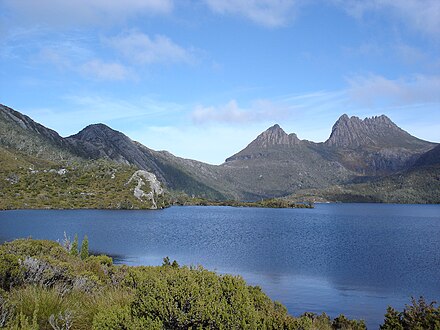

- Ben Lomond National Park 📍 – mountain with a ski resort.
- Bruny Island 📍 – perhaps Tasmania's most visited offshore island
- Cradle Mountain-Lake St Clair National Park 📍 – one of Tasmania's most iconic landmarks and contains the Overland Track, part of the Tasmanian Wilderness .
- Franklin-Gordon Wild Rivers National Park 📍 – part of the Tasmanian Wilderness , home to several waterfalls. It is Tasmania's second largest national park.
- Freycinet National Park 📍 – known for its beaches and bay.
- Hartz Mountains National Park – another mountainous national park, just one hour away from Hobart
- Mount Field National Park – one of the more visited national parks in Tasmania, and a popular skiing area
- Port Arthur 📍 – former convict settlement and a
- Southwest National Park 📍 – Tasmania's largest national park in the southwest of the island, part of the Tasmanian Wilderness . It is a good place to spot the Southern Lights.
Understand
History
Tasmania has been inhabited by humans for approximately 60,000 years. Between around 6,000 BCE, sea levels rose and Aboriginal Tasmanians were entirely isolated from the rest of the human race, until the first contact with Europeans in 1777.
The first reported sighting of Tasmania by a European was on 24 November 1642 by the Dutch explorer Abel Tasman. Captain James Cook landed at Adventure Bay in 1777. Matthew Flinders and George Bass first proved Tasmania to be an island in 1798–99.
The first European settling of Tasmania was by the British at Risdon Cove on the eastern bank of the Derwent estuary in 1804. Penal settlements were established at Sullivans Cove (Hobart), Maria Island, Sarah Island, and Port Arthur. The colony changed its name from "Van Diemen's Land" to "Tasmania" in 1856. The Colony of Tasmania existed from 1856 until 1901, when it federated with the five other Australian colonies to form the Commonwealth of Australia.
Geography
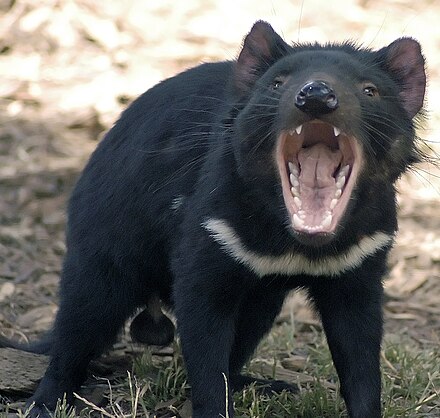 Tasmanian devils
Tasmanian devils
This carnivorous marsupial is the size of a small dog and found only in Tasmania. The largest carnivorous marsupial in the world, it is characterised by its stocky and muscular build, black fur, extremely loud and disturbing screech, and ferocity when feeding. Despite its appearance, the devil is capable of surprising speed and endurance and can climb trees and swim across rivers. Since the 1990s, a deadly disease, devil facial tumour disease, has drastically reduced the devil population and now threatens the survival of the species, which in 2008 was declared to be endangered. The disease is a transmissible cancer, which means that it is contagious and passed between animals when fighting, causing individual devils to die within months being infected. Programs are being undertaken to reduce the impact of the disease, including an initiative to build up isolated colonies of healthy devils in captivity. As of 2008 there were an estimated 10,000–15,000 remaining in the wild, but the decline is so rapid that they are predicted to become extinct before the year 2035. There are people that wish to take a more genetically resistant strain from the North West of Tasmania and introduce them to areas of mainland Australia where there are no dingoes in order to reduce feral cats and foxes and allow a better chance of survival for Australian native animals.
Located in the Southern Ocean separated from mainland Australia by the Bass Strait and from New Zealand by the Tasman Sea, Tasmania is Australia's smallest state, with an area of 68,400 km² (26,410 square miles). It is comparable in size to the Canadian province of New Brunswick or the country of Ireland. It's within the range of the notorious "Roaring Forties" winds that encircle the globe.
Tasmania's population is focused in the southeast and north in the regions around the cities of Hobart, Launceston, Burnie and Devonport.
The Midlands (the area between Hobart and Launceston) is the driest region of Tasmania and is primarily used for cattle and sheep grazing. The Huon Valley and the area between Launceston and Burnie is used for both agriculture and horticulture. The Central Highlands, the West Coast and the Southwest Wilderness are all mountainous forested areas, a majority of which are protected inside national parks.
Tasmania is very mountainous: while its tallest mountain, Mount Ossa, at 1,617 m (5,305 ft) is not that high compared to global standards, the mountains are what characterise Tasmania. Much of Tasmania is densely forested, with Southwest National Park and neighbouring areas home to some of the last pristine temperate rainforests in the Southern Hemisphere.
Climate
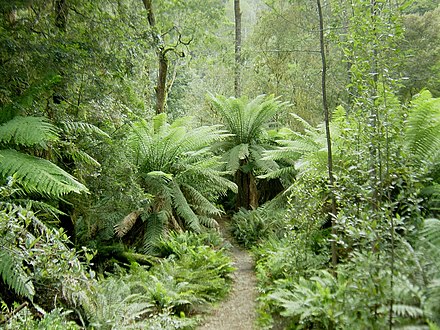 Tasmania typically has more rainy days than anywhere else in Australia, with "four seasons in a day" being often the norm. The southwest and West Coast in particular receive a great amount of rainfall - so much of it that it is considered uninhabitable. Both cold waves from Antarctica and heatwaves from the mainland can reach the island anytime. The sea temperature is rather low throughout the year, even in the north.
Tasmania typically has more rainy days than anywhere else in Australia, with "four seasons in a day" being often the norm. The southwest and West Coast in particular receive a great amount of rainfall - so much of it that it is considered uninhabitable. Both cold waves from Antarctica and heatwaves from the mainland can reach the island anytime. The sea temperature is rather low throughout the year, even in the north.
Tasmania has a cool temperate climate, comparable with that of northern Europe and/or Vancouver in British Columbia, Canada, with the following seasons:
- Spring from September to November, with frequent snowfalls at higher elevations.
- Summer from December to February. It has about 15 hours of daylight from 5:30AM to 8:30–9:30PM.
- Autumn from March to May. Changeable weather.
- Winter from June to August. High areas receive a good amount of snowfall. It has the least daylight with about 9 hours a day from 8AM to 4:30PM, but sometimes even earlier, especially in the Huon and Far South.
Economy
 Tasmania's main industries are mining (including copper, zinc, tin, and iron), forestry, agriculture, fresh produce (fruit, vegetables, dairy, seafood, beer and wine), and tourism. The economy is affected by the Bass Strait, and how the freight and transport issues of goods into and out of the island are costed and subsidised, at times there are more Tasmanian-born people in Melbourne, than there are in Tasmania, due to the nature of the Tasmanian job market.
Tasmania's main industries are mining (including copper, zinc, tin, and iron), forestry, agriculture, fresh produce (fruit, vegetables, dairy, seafood, beer and wine), and tourism. The economy is affected by the Bass Strait, and how the freight and transport issues of goods into and out of the island are costed and subsidised, at times there are more Tasmanian-born people in Melbourne, than there are in Tasmania, due to the nature of the Tasmanian job market.
Holidays
National public holidays can be found in the main Australia article.
Statewide public holidays
- 8-Hour Day (Labor Day): Second Monday of March (Eight Hours Day)
- Recreation Day: First Monday in November (Except areas that observe Royal Hobart Regatta)
Regional public holidays These apply to smaller areas of Tasmania:
- Wednesday not earlier than fifth and not later than eleventh day of January: Devonport Cup (Devonport only)
- Last Wednesday of February: Launceston Cup (Launceston and surrounds)
- Second Monday of February: Royal Regatta Day (Southern Tasmania only)
- First Tuesday of March: King Island Show (King Island only)
- The Friday nearest the last day of November: AGFEST (Circular Head only)
- The Friday before the first Saturday of October: Burnie Show (Burnie, Waratah-Wynyard and West Coast)
- Thursday before the second Saturday of October: Royal Launceston Show (Launceston and surrounds)
- The Friday before the third Saturday of October: Flinders Island Show (Flinders Island only)
- The Friday before the third Saturday of October: Royal Hobart Show (Southern Tasmania only)
- The Friday nearest the last day of November: Devonport Show (Devonport, Kentish and Latrobe only)
Time zone
Tasmania follows the same time zone as New South Wales, Victoria and the Australian Capital Territory: Australian Eastern Standard Time (UTC+10). Like the two southeastern states, Tasmania also observes daylight savings and follows the Australian Eastern Daylight Saving Time (UTC+11) between the first Sunday of October and April.
Get in
By plane
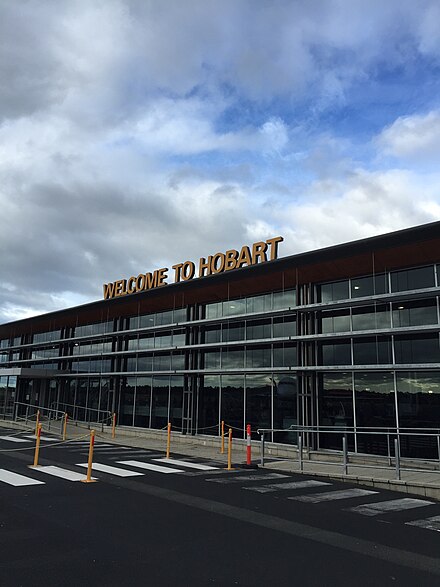 There are no international scheduled flights to Tasmania, except from New Zealand. All other flights must come through mainland cities. There are seasonal flights over Antarctica.
There are no international scheduled flights to Tasmania, except from New Zealand. All other flights must come through mainland cities. There are seasonal flights over Antarctica.
- Flights to Hobart from Melbourne, Sydney, Brisbane, and the Gold Coast as well as Auckland.
- Flights to Launceston from Melbourne, Sydney and Brisbane.
- Flights to Burnie and Devonport from Melbourne.
- Flights to King Island and Flinders Island from Melbourne.
See the local guides for more information.
By ferry
There is only one ferry route, which are the two Spirit of Tasmania Ferries from the Spirit of Tasmania terminal in Geelong and arrive at Devonport. See the Devonport article for the details of the ferry. It takes a full night (or the full day during peak summer periods) for the crossing and takes vehicles, bikes, foot passengers and pets.
The crossing can be a little choppy at times, but provides beautiful sunsets and costs around $200–300 each way (excluding the cost bringing a vehicle). You have the option of booking one of a range of a cabins or a reclining chair for the journey.
Crossings can also be part of cruise ship itineraries.
Rental car companies usually have restrictions on taking vehicles into or out of Tasmania on the ferry. If you have rented a car on the mainland and need a car to tented in Tasmania, it's best to drop the car off in Geelong, Victoria; rental cars are available at the Devonport terminal.
Get around
By car
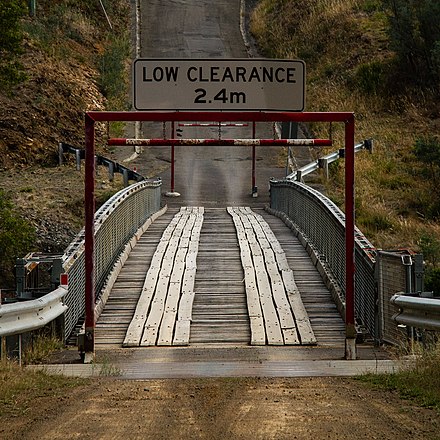
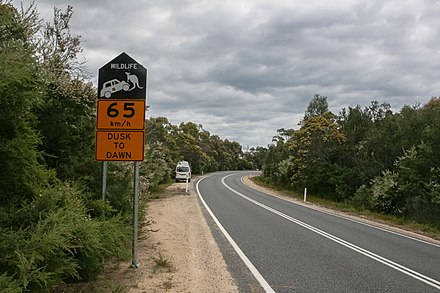
Tasmania's speed limits are more liberal than the three states on the mainland's East Coast. By default, the maximum urban limit is 50 km/h, 80 km/h on gravel roads and 100 km/h on rural roads. However, on most rural roads, the government has practically adopted a "drive to conditions approach" by setting a 100 km/h limit on even the most windiest of roads with few to no slow or overtaking lanes. In practice, if you're new to the area, you may struggle to even travel 80 km/h on these roads, but the limit is for those who are experienced with such road conditions. Remember, if you are not comfortable driving 100 km/h on "100 km/h changing road conditions" roads, you do not have to drive 100 km/h. You may also encounter 110 km/h limits on the Midland, Bass and Tasman Highways.
Tasmania has four main road classifications: National Highway, A-routes, B-routes, and C-routes. The only national highway is Tasmanian National Highway 1 comprising of the Brooker, Midland and Bass Highways between Hobart and Burnie. A-routes connect major regional centres, B-routes connect minor towns to major regional centres or highways, while C-routes are smaller roads that typically connect B-routes to an even smaller destination. A route number does not necessarily reflect the road quality: until 2019, the A5 (Lake Highway) through the Highland Lakes was unsealed, and other A-routes such as the A3 are more windier than many B-routes in the north.
Many major roads, even A-routes, wind their way through mountain passes and along coastlines, narrow and with few overtaking lanes, and some sections of remote roads may be in need of repair. Direct roads on the maps may take longer than you think. Take care on some of the winding or secondary roads, since some ute drivers and locals may try to overtake on dangerous stretches of road or tailgate you if you aren't travelling fast enough. Some local drivers, especially in suburban and semi-open areas (e.g. Bass Highway), will also tailgate and attempt dangerous manoeuvres to pass or overtake you, especially if they see you are driving a hire car.
Be especially careful driving between dusk and dawn as this is when the wildlife is most active: keep on the lookout for wallabies, devils, possums and others. Tasmania has the unfortunate distinction of being the roadkill capital of the world. Wallabies and wombats can make a mess of your vehicle if hit. The Tasmanian government generally advises you drive 65 km/h between dusk and dawn and 45 km/h in some places like the Tasman Peninsula (Tasman Island).
Exploring the forests can often lead to a maze of forest roads. A GPS can come in handy for finding your way out, although they are not always up to date.
By bus
Buses can be an option if time is on your side, but otherwise isn't a feasible way of getting around. Planning is advised since services can be infrequent. Redline Tasmania and Tassielink are the main long distance bus companies, with population centres serviced by Metro Tasmania for Burnie, Hobart and Launceston and Merseylink that provide services to Devonport and Latrobe. If you are not in a major town (e.g. Hobart, Launceston) bus services can be infrequent, expensive and hard to rely on. Make sure you have a copy of the timetable with you.
By train
There are no public train services. The many railways seen crossing minor roads are used for freight only. The only non-freight railway of any kind is the West Coast Wilderness Railway, a tourist train which runs between Strahan and Queenstown on the West Coast. The trip takes about 3 hours with lunch included (very slow compared to the 30-minute car journey).
By plane
- Par Avion offer scenic flights across the state and services into Melaleuca in Southwest National Park.
- Airlines of Tasmania offer flights between Launceston and Cape Barren Island.
- Sharp Airlines offer flights to Flinders Island from Launceston and flights to King Island from Launceston and Burnie.
By bicycle
Bicycle touring is a popular way to see cities Tasmania, but driving on rural roads can be very dangerous. Bicycle rental companies can be found in major cities and towns.
See
Wildlife
See also: Australasian wildlife

If you spend any time in the bush you are very likely to see:
- Kangaroos, wallabies, and pademelons are everywhere throughout Tasmania.
- Wombats can be found in many national parks and mostly come out at night.
- Ringtail and brushtail possums only come out at night.
Less common wildlife include:
- Echidnas are rarely seen in the bush. They're more easily spotted when crossing roads.
- Bandicoots and Potoroos are at the small end of the jumping marsupial scale.
- Platypus are very elusive. If you are persistent and very quiet and still you may find one rummaging at the bottom of a creek.
- Eastern and Spotted-tail Quolls very rarely seen.
- Tasmanian devils are rarely seen in the wild. They can sometimes be spotted along roadsides eating roadkill at night and sometimes on the edge of rural towns.
Landmarks
See also: Tasmanian national parks
-
kunanyi / Mount Wellington is a large mountain that rises above Tasmania's capital city. Visitors can drive to the top, where a viewing lookout is located, and well maintained walking tracks are located in the foothills. A coffee van operates at the Springs, a picnic area mid way up the mountain.
-
Bay of Fires is one of Tasmania's most popular tourist destinations, located between Eddystone Point and Binalong Bay. Bay of Fires has beautiful blue water, red rocks, and sandy white beaches. Enter through Binalong Bay which is 10 minutes from St Helens. This area offers a wide range of activities including camping, boating, bird watching, fishing, swimming, surfing, and walking along the coastline.
-
Cataract Gorge is a unique, natural formation within a two-minute drive from central Launceston known to locals as The Gorge. After walking 15 minutes from central Launceston along Tamar River into Gorge, you then follow the pathway along the cliff face looking down onto South Esk River. On the southern side, called the First Basin, there is a cafe, swimming pool, and Launceston's beach. The northern side, known as the Cliff Grounds, there is a kiosk, restaurants, swimming pool, and a chairlift across the river. The Cataract Gorge Reserve is one of Australia's most fascinating urban parks.
-
Hastings Caves include Newdegate Cave, the largest cave in Australia open to tourists. Tour magical chambers of flowstones and shawls, then relax in a thermal pool. Formations in the cave are spectacular and include flowstone, stalactites, columns, shawls, straws, stalagmites and the unusual helictites - tendrils of calcite that grow in all directions in tiny filaments.
-
Mole Creek Karst Tasmania's only national park featuring caves. Among many features are the King Solomon and Marakoopa Caves, both of which can be viewed with Tasmania Park Service guides leading you. Both caves are distinctly different and a separate entry ticket is required for each. Tour times are staggered throughout the day. Five world heritage listed convict sites are located in Tasmania, in the northeast and south of the island. The best known is likely Port Arthur.
](https://upload.wikimedia.org/wikipedia/commons/thumb/c/c2/PortArthurPenitentiary.jpg/440px-PortArthurPenitentiary.jpg)
-
Port Arthur is the best preserved convict site in Australia. Many years ago, this site was a key role in the colonial system of convict discipline. During your experience, you will have the chance to take guided tours of the Commandant's House, Parsonage, Trentham Cottage, Junior Medical Officer's quarters, historic buildings and ruins of the Penitentiary, Barracks, Guard Tower and military precinct, Hospital, Paupers' Depot and Asylum. Port Arthur is surrounded by beautiful bushland and trails available to explore the land around you.
-
Ross is another convict town, but is not listed as a world-heritage site. It's known for its convict-built bridge and its old female factory, both of which are popular stopover destinations for those travelling on the Midland Highway between Hobart and Launceston.
-
Salamanca Place in Sullivans Cove, is Hobart's favourite hang out. Salamanca is lined with a long row of sandstone buildings built in the 1830s. You can wander under the heavy stone arches to find craft and design shops, jewellers, coffee shops, restaurants, bookshops, fashion boutiques, and the Salamanca Arts Centre and artists’ galleries. Every Saturday there’s the Salamanca Market, where you can buy anything from a handmade wooden toy or a hand-spun, hand-knitted sweater to fresh fruit and vegetables or a 50-year-old china plate.
-
The Nut is located at the historic village of Stanley, in far north-west Tasmania. The Nut, a sheer-sided bluff is all that remains of an ancient volcanic plug. A walking track climbs to the summit of The Nut, or you can take the chairlift, with spectacular views across Bass Strait beaches and over the town. There is accommodation and an excellent campground in Stanley, and the town is a good base for exploring the forests and coastlines further west.
Do
- Trout fishing. Trout Guides and Lodges Tasmania Incorporated (TGALT) is the industry body, that was voluntarily formed in 1981 as the Tasmanian Professional Trout Fishing Guides Association. Its primary purpose was to provide anglers with a source of guides that they could be assured, would provide a safe, appropriate and professional service. During 1995 the Association was expanded to specifically include trout fishing lodges as full members.
- The Overland Track. The iconic bushwalk from Cradle Mountain to Lake St Clair - bookings essential during the main walking season (November to April).
- The South Coast Track. The bushwalk along the south coast of Tasmania, from Melaleuca, to Cockle Creek - fly in by aircraft and take a 6-day walk back home
- The Great Tasmanian Bike Ride - held in early February.
- Bicycle touring and mountain biking - there are some great places to ride your bicycle in Tasmania.
- Scuba diving - Tasmania is home to some of the best temperate diving in the world. Along with its giant kelp forests and numerous shipwrecks, the waters reefs also offer an array of unique marine plants and animals. There are many dive sites along the coast, the most popular sites are at Bicheno, Bay of Fires, Flinders Island, Fortescue Bay, Tasman Peninsula and Maria Island.
- Off road touring - Tasmania is a very rugged and heavily forested region, tourists happen to miss out on some incredible places if they do not have a vehicle with four-wheel-drive. Visitors can explore these trails with an experienced operator or either form or tag along with a group. Before exploring, make sure you have a current map of the area. In 2003, Tasmania changed the co-ordinate system used for all maps from AGD 66 to GDA 94. Also, ask the local land manager for the latest information on the condition of the area you plan to use and permits.
- Wildlife watching. Because of its separation from mainland Australia, Tasmania is home to many of the animals or plants that are rare or even extinct in other areas around the world. If visitors are watchful, they are very likely to witness these species on trails or near streams. Tourists can also be by a tour guide to point out these animals so you won't miss them! Some of these rare mammals include the Tasmanian Devil, Platypus, Echidna, Sugar Glider, Eastern Quoll, and Forester Kangaroo.
- Hang gliding and the Flying Fox. Hollybank Treetops Adventure takes visitors across treetops and gives them the experience of seeing Tasmania's forests in a whole new way - bird's-eye view! These canopy tours last for 3 hours and are led by highly trained professionals. Not only do guests take part in this unique adventure by soaring across about a kilometre of cable but they also learn about the forests below them.
- Kayaking. After landing in Hobart's Airport, you are a mere 20 minute drive away from beginning your kayaking experience. Visitors can explore Tasmania's beautiful coastlines and search out secret coves by kayaking. There are professional kayak guides based in Hobart, Kettering, Port Arthur, Coles Bay, Launceston, and Strahan. Kayak travel through Tasmania's beautiful landscape offers relaxation and exhilaration that tourists will not want to miss out on.
- Adventure activities including abseiling, all-terrain vehicles, bicycle touring, caves and caving, diving, jet boats, kayaking, mountain biking, rock climbing, skiing, sky diving, swimming, surfing and whitewater rafting
Buy
One of Tasmania's most famous products is leatherwood honey, and there are numerous honey farms on the island in which you can purchase this.
Like elsewhere in Australia, tipping can be considered very unusual, however, most of the time, it's well appreciated. Most Tasmanian's wages are well below the mainland so don't be surprised if the people here are a lot more grateful. On the other hand, unlike in the US, you probably won't be frowned upon at if you don't - because tipping in Australia is quite unusual.
American Express credit cards are almost universally rejected by local businesses, even major chains and most branches of the state government.
Tasmanian businesses no longer give out free plastic bags. Most local government areas also ban single use plastics for takeaway food.
Eat
See also: Australian cuisine
Tasmania has a wide variety of culinary offerings. Tasmania produces a wide range of cuisines, both quintessentially Australian foods, and a wide range of international offerings. Tasmania has a diverse immigrant community which has contributed to a colourful range of cuisines. Tasmanian produces much of its own food, including many crops you wouldn't expect - such as saffron, tea, truffles and wasabi. Many regions of Tasmania have particular specialties - for example King Island produces gourmet cheeses and beef and the Huon Valley is most famous for apples.
Being surrounded by the sea, it is no surprise that Tasmania also has a strong seafood culture - with many dedicated seafood restaurants offering salmon, abalone, scallops, oysters, mussels and crayfish. Curried scallop pies are a particularly well known Tasmanian specialty.
There is a list of vegetarian and vegetarian friendly eateries in Tasmania.
Drink
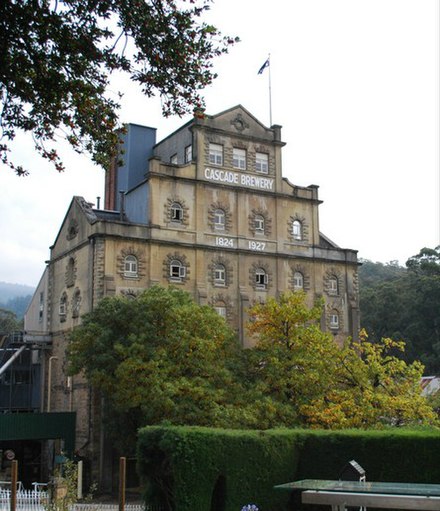 Tasmania has many exceptional world class beers, whiskies & wines.
Tasmania has many exceptional world class beers, whiskies & wines.
There are two major breweries in Tasmania; Cascade Brewery in Hobart and J. Boag & Sons Brewery in Launceston, which each offer tours. A number of boutique beer makers and distillers are spread around the state.
You can tour the Tasmanian Wine Routes easily by car or on guided tours. The island's Wine Routes include the Tamar Valley, north of Launceston along both sides of the Tamar River and east to Pipers River; the Derwent, Coal River and Huon Valleys (together comprising the Southern Wine Route), an easy drive from Hobart; and the growing wine regions of the North West and the East Coast.
Tasmania is the centre of Australia's craft whisky industry, and there are numerous distilleries throughout the state. Due to the similarity of Tasmania's climate to that of Scotland, Tasmanian whiskies are primarily based on Scotch whiskies. Unlike in other areas, there is no large-scale commercial whisky distillation in Australia, and the industry is dominated by small boutique distilleries. Two of Tasmania's most important distilleries are Sullivans Cove in Cambridge, and Lark in Hobart, both of which have won prestigious international awards.
Tasmania also has a strong cider culture, with a number of small to medium boutique cider producers including Willie Smiths, Pagan Cider, Franks Cider and Lost Pippin. The Tasmanian cider industry operates a Tasmanian Cider Trail for those who want to undertake a self-guided tour, and Willie Smiths celebrates an annual Mid Winter Fest, including traditional wassailing - the pagan practice of scaring the evil spirits away from the apple trees.
Tasmania is also home to several craft vodka and gin distilleries. There are also a wide range of local non-alcohol beverage producers. Tasmania has several well-regarded tea companies - the Tasmanian Tea Company, Tassie-T and the Art of Tea - whose drinks can be found in local restaurants and boutique grocers. Hartz and Juicy Isle both produce local sodas and cordials, and Westerway Farms and Juicy Isle continue to produce Tasmania's famous blackcurrant cordial, once made by Cascade.
The legal drinking age is 18 years. It is illegal either to purchase alcohol for yourself if you are under 18 years of age or to purchase alcohol on behalf of someone who is under 18 years of age. The only legally acceptable proof-of-age documentation are an Australian drivers licence, state-issued proof-of-age card, Keypass card or a passport, and it would be wise to carry one if you want to purchase alcohol or tobacco and look under 25 - vendors will frequently ask for ID for anybody who looks to be 25 or younger. In Tasmania, foreign drivers licences and foreign ID cards are NOT legally acceptable as proof of age documentation, and people who are unable to produce a passport or valid Australian ID will be refused service. Only actual ID documents will be accepted - photographs or photocopies will NOT be accepted.
Sleep
There is a variety of accommodation options available across the state, from camping through to 5-star luxury. Tasmania is particularly renowned for its hosted bed and breakfast accommodation where you can experience a different way of life in a whole range of different properties, including heritage listed and more modern properties in stunning locations.
There are four YHA (Hostelling International) branded hostels in Tasmania and a number of independent operators spread around the state. Prices range anywhere from $10-30.
Respect
Tasmanians are generally more laid-back and friendly than their mainland counterparts. They are usually very willing to help you out or give advice when asked.
You should also mind that it is never a good idea to bring up the 1996 Port Arthur Massacre (the worst mass shooting in modern Australian history), even when you are outside Port Arthur as it may be a sensitive issue to some, even if they were not present at the scene. On the contrary, Tasmanians are very laid back when talking about the island's convict history, people here are unlikely to be offended by it.
Stay safe
In the bush
Bushwalking can be a truly breathtaking experience in Tasmania, but be sure to obtain the right gear, local advice and maps. Always sign the logbook at the beginning and end of each walk. Be aware that mobile coverage is limited in wilderness areas. The main dangers of bushwalking are getting lost and/or suffering from hypothermia. Tasmania's weather is notoriously changeable. Be sure to take a good raincoat and warm clothes with you even on a sunny day because an hour or two later it could be pouring with rain. If undertaking more serious bushwalking a map and compass is a must, as is a good sleeping bag and tent for multi-day walks.
Mosquitoes are present all year round. There are no mosquito-born viruses. A good repellent is advisable if going into the bush.
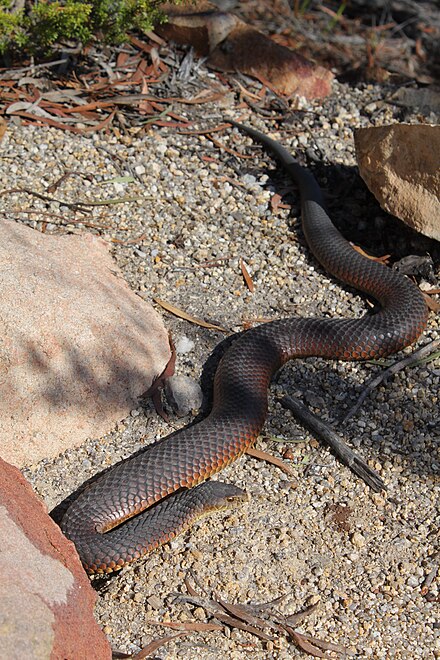
Wildlife
There are three species of snake in Tasmania: copperhead, white-lipped, and tiger. The tiger snake is one of the most venomous snakes in the world, but don't let that deter you. No one has died from a snake bite in Tasmania since 1977. All three use the same anti-venom so identification of the snake is not important. Most snakes will slither away as soon as they hear you coming.
Water
While in wilderness areas the water may be good to drink, but it is still highly recommended that you boil before consumption. If in touristy areas, such as The Overland Track, always boil your water or risk gastro.
Bushfires
During the Tasmanian bushfire season, which runs from roughly October to March, be vigilant and keep aware of local news. Bushfires can start and spread rapidly, even in urban areas. Many Tasmanian towns have just one exit, so it is worth planning ahead - even if a bushfire is hours away, it may be too late to leave if you wait.
In times of high fire danger, it may be worth reconsidering any activities that take you too deep into the bush. Check the Bureau of Meteorology website to assess the fire rating before going. The Tasmanian Fire Service provides an incidents list on its website, but this may be several hours out of date at times. ABC Local Radio (936 AM in Southern Tasmania, and a variety of frequencies in Northern Tasmania) is often the most up to date with emergency information, and can also be accessed online or on your phone.
Go next
- Geelong and Melbourne are obvious next destinations, with the former easily reachable by ferry and the latter by plane.
- Antarctica from Hobart has scheduled flights during summer months